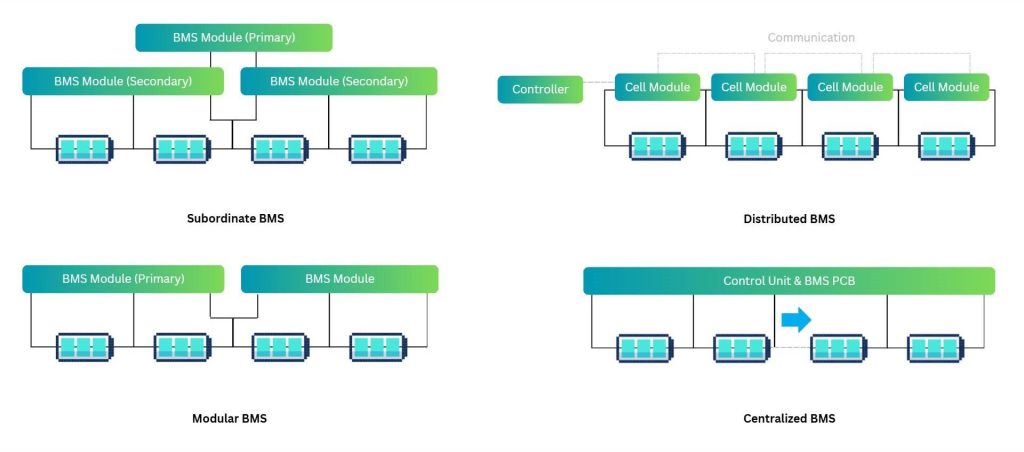What is a Battery Monitoring System?
Battery management and monitoring systems oversee the battery pack of an electric vehicle, which is basically an assembly of cells that are electrically positioned as a matrix. The pack assembly delivers a certain range of current and voltage for a particular duration and keeps track of voltage of individual cells. This comprehensive system manages the overall performance of the batteries and ensures their safety against potential damage by preventing cell functioning over a safe operating area (SOA) or range. It monitors the battery’s longevity by ensuring even and balanced charging and discharging cycles. It also exhibits temperature control to prevent freezing and overheating through active and passive cooling systems for maintaining the required operational conditions. The BMS estimates the state of charge (SOC), the remaining energy capacity in the batteries and its total lifespan which is the state of health (SOH). It calculates the secondary data as per the battery’s state, reports and authenticates it and controls or balances the environment for optimal performance.
Thus, the overall complex functioning of the battery management system (BMS) spans across many disciplines including thermal, hydraulic, electrical and digital control in electric vehicles similar to monitoring of external functions using a 360-degree camera for car. As of 2021, the electric vehicle battery management system market was valued at ₹118.68 billion worldwide and is expected to surge and reach a value of ₹473.8 billion by 2027 at a CAGR of 17.2% during this period. In India, the BMS market for electric two and three-wheeler vehicles was valued at ₹9.42 billion in 2022 and is predicted to reach a valuation of approximately ₹193.9 billion by 2032, rising at a CAGR of 32.48%.

Market size of battery management system in electric vehicles from 2022 to 2032
What Does the Battery Control Module Do?
Battey control module (BCM) perform similar functions as the BMS, where the former is a component within the broader BMS framework, and the latter is an overarching system to monitor, manage and oversee safety features of the battery pack assembly. The BCM focuses on controlling specific functions of the battery such as implementing a fail-safe mechanism to prevent over-discharging, undercharging, overcurrent, overcharging etc. hazardous conditions. It implements control algorithms to regulate charging and discharging processes and identifies faults and anomalies in the pack assembly. It logs data related to battery performance, diagnostics, maintenance, troubleshooting and optimization as a part of the BMS. Also, it interfaces with other components such as vehicle control units for electric vehicles, to provide battery status, updates, commands and exchange data in real-time to enable remote monitoring and control through Android application development.
Types of Battery Management Systems
In order to choose the right BMS, several factors need to be considered such as battery chemistry for particular needs, requirements of voltage, current, communication and cost versus value balance.
Battery Chemistry-Specific
1. Lithium-ion: These are lightweight, easy to maintain, cost-effective and highly adaptable rechargeable batteries with a longer lifespan and high energy density that can withstand numerous charge and discharge cycles. Thus, the BMS needs to maintain a fast pace within its SOA that does not induce stress during charging though these batteries can work efficiently in rigorous working conditions.
2. Lead-acid: These types of rechargeable batteries have a substantially high topology and were previously used by manufacturers. They are commonly known for reliability, low cost per wattage and high energy storage.
3. Nickel-metal hydride: These types of battery management systems are used for performance optimization and consider safety and efficiency as important factors of compliance, although they have limited versatility for use with other battery chemistries.
BMS Architecture
1. Centralized: In these types of battery management systems, the entire pack is managed by a single control unit which reduces scalability for larger battery systems, though the design is simple and cost-effective, for example, Tesla Model S.
2. Modular: The battery pack is segregated into smaller modules with separate BMS controllers that interact with a master controller, thus providing scalability and redundancy, for example, Tata Curvv.ev.
3. Distributed: In this type of architecture, a dedicated circuit for managing batteries is allotted for every cell or a small group of them. Though it offers improved redundancy and granularity, the design can be expensive and complex to implement, for example, Nissan Leaf.
4. Subordinate: This design contains smaller battery modules and a master controller, but the slaves can only relay measurement-related information, while the latter exerts control, external communication and computation. Similar to modular architecture, it is cost-effective with lesser overhead due to the simpler functionality of slaves.
Cell Balancing-Based
1. Passive: In this case, the BMS utilizes the passive cell balancing technique of dissipating excess energy as heat to manage cell charge levels. Here, cell balancing refers to maintaining equal voltage levels of each individual cell connected in series to form a battery pack assembly for maximum efficiency. Though it is simpler and cost-effective; it is less efficient, especially for larger packs.
2. Active: The BMS actively redistributes energy between cells with the help of capacitors or other energy sources to balance their charge levels. It is costlier and more complex as compared to the former option, but it leads to efficient balancing and improves battery performance and lifespan.
BMS Complexity
1. Basic: These are the simplest types of battery management systems that feature indication and protection against overvoltage, undervoltage, overcurrent and overtemperature.
2. Standard: They showcase features such as cell balancing, control of charge, protection against excess voltage, current, temperature and communication with other systems of the electric vehicle.
3. Integrated: Similar to standard BMS, they function beyond the management of batteries and combine functioning with other vehicle control systems, for example, thermal management and power distribution. This optimizes vehicle performance and reduces weight through consolidation of components, which can vice versa lead to single points of failure and complex design.
4. Smart: These have a bit more expensive and complicated design than other versions of BMS and include all the features of the previous forms. Additionally, they also present software-enabled complex functions such as SOC, SOH estimation, remote diagnostics using web app development services, real-time monitoring, IoT-powered connectivity features, data analytics, integration with fleet management systems and predictive maintenance, for example, Mahindra Reva e2o+.

Different architectures for battery management system lithium-ion type
Benefits of Battery Management System in Electric Vehicles
Given below are the benefits of implementing battery management systems –
- The BMS protects the electric vehicle from various hazardous events such as thermal runaway (increase by 20°C per minute) and fires, by continuously monitoring the battery pack.
- The battery control module assists in maximizing the cell’s lifespan through cell balancing, temperature management, state of charge and state of health estimation.
- Battery pack protection management handled by BMS ensures that all cells are used as per their SOA requirement against aggressive usage, fast charging and discharging, ensuring reliable service.
- It assures the delivery of a consistent power output and optimized performance by managing the pack operations within ideal parameters (-8A to 15A; 2.5V to 4V; -20°C to 60°C during discharging and 0°C to 45°C during charging).
- The BMS seamlessly integrates with the vehicle systems and interfaces with the electronic control unit (ECU) for coordinated operations and actuation.
- As the longevity of the battery pack increases with predictive maintenance, lowered breakdowns and preventive premature replacements, the battery control module leads to cost savings.
- It showcases built-in performance diagnostics, analysis, logs data to enable troubleshooting, proactive maintenance and assists manufacturers in improving future battery designs and software.

Working of battery management system in electric vehicles
- It improves overall efficiency by optimizing energy distribution within the pack and works with regenerative braking systems to store energy effectively.
- It keeps individual cells at similar charge levels, prevents weaker cells from getting discharged at a faster pace or a too low levels to avoid stressing the battery and improve lifespan.
- The battery monitoring system completes the requirements of a compliant electric vehicle system which includes stringent regulations like IS 17387:2020, related to communication between the components such as the blind spot monitoring system.
- The presence of a well-designed and compliant BMS that meets safety and environmental regulations also assists in gaining consumer trust.
- The BMS offers real-time monitoring and customizable alerts related to the battery status, range and health over intuitive dashboard displays and human machine interface designs.
- Lithium-ion BMS are especially useful or large formats and leave minimal room for management-related errors, ensuring user safety.
- It showcases continuous monitoring and adequate computations for SOC estimation, and this data is leveraged or cell balancing and shared with external devices to indicate resident energy, expected lifetime, ranges as per current usage and state of health of the battery pack assembly.
- Introduction of battery management system Lithium-ion and other types into battery energy storage system (BESS) drive down overall and warranty costs due to its protection and diagnostic features, functional safety, preventive and predictive maintenance etc.
Leverage KritiKal’s Robust Battery Monitoring System
In this blog, we observed various functions of the BMS, its types, components and advantages. It is a notable fact that all these fields of the BMS are constantly evolving as per the increasing demand for safer, smarter electric vehicle solutions and autonomous driving systems. KritiKal Solutions is completely aligned with these advancements and integrates the latest trends to shape the future of EVs in India. It leverages AI/ML models to improve cell balancing, liquid thermal management, SOH and SOC estimation. It can customize the solution for remote monitoring and receiving over-the-air updates through wireless communication and IoT. Our BMS features a modular, distributed and scalable architecture that can accommodate systems of batteries of different types, sizes and complexities.
The multifunctional battery control module imparts functional safety, system integrity and risk mitigation backed by cybersecurity measures. We are driven to expand the role of our lightweight and compact BMS to meet the demands of automotive-constrained applications such as energy management, power electronics control and seamless integration with various systems of electric vehicles. We ensure redundancy and ease with predictive maintenance capabilities, innovative, sustainable and reliable BMS as this field of technology continues to advance. Please contact us at sales@kritikalsolutions.com to avail our services vouched by several automotive giants in India.

Sai Revanth currently works as an Embedded Design Engineer at KritiKal Solutions. He has expertise in embedded electronics development, PCB and circuit design, working with analog semiconductors, inductors, RFID, testing and more. He has helped KritiKal in developing and delivering robust embedded solutions to some major automotive clients.

 Global
Global  United States
United States 